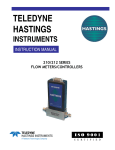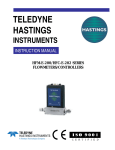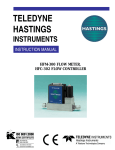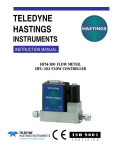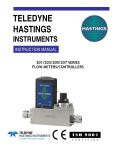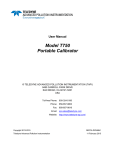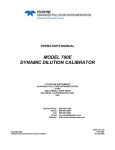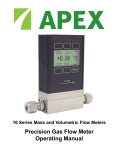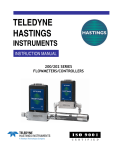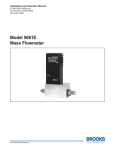Download Manfrotto 201 Automobile Parts User Manual
Transcript
TELEDYNE
HASTINGS
INSTRUMENTS
INSTRUCTION MANUAL
201/203 SERIES
FLOW METERS/CONTROLLERS
Manual Print History
The print history shown below lists the printing dates of all revisions and addenda created for this
manual. The revision level letter increases alphabetically as the manual undergoes subsequent
updates. Addenda, which are released between revisions, contain important change information that
the user should incorporate immediately into the manual. Addenda are numbered sequentially.
When a new revision is created, all addenda associated with the previous revision of the manual are
incorporated into the new revision of the manual. Each new revision includes a revised copy of this
print history page.
Revision A (Document Number 141-0999) ..........................................................................September 1999
Revision B (Document Number 141-1199)............................................................................ November 1999
Revision C (Document Number 141-102002) ........................................................................... October 2002
Revision D (Document Number 141-082005) .............................................................................August 2005
Revision E (Document Number 141-062008).................................................................................. June 2008
Revision F (Document Number 141-092008)........................................................................September 2008
Visit www.teledyne-hi.com for WEEE disposal guidance.
CAUTION:
The instruments described in this manual are available with multiple pin-outs.
Ensure that all electrical connections are correct.
CAUTION: The instruments described in this manual are designed for INDOOR use only.
CAUTION:
The instruments described in this manual are designed for Class 2 installations
in accordance with IAW/IPC standards
Hastings Instruments reserves the right to change or modify the design of its equipment without
any obligation to provide notification of change or intent to change.
201/203 Series
Page 2 of 20
Table of Contents
1.
GENERAL INFORMATION............................................................................................................................................ 4
1.1.
1.2.
1.3.
1.4.
2.
INSTALLATION AND OPERATION ............................................................................................................................. 7
2.1.
2.2.
2.3.
2.4.
2.5.
2.6.
2.7.
3.
OVERALL FUNCTIONAL DESCRIPTION: ...................................................................................................................... 12
SENSOR:..................................................................................................................................................................... 12
ELECTRONICS: ........................................................................................................................................................... 12
SHUNT: ...................................................................................................................................................................... 13
VALVE: ...................................................................................................................................................................... 14
MAINTENANCE.............................................................................................................................................................. 15
4.1.
4.2.
4.3.
4.4.
4.5.
4.6.
4.7.
4.8.
5.
RECEIVING INSPECTION ............................................................................................................................................... 7
POWER REQUIREMENTS ............................................................................................................................................... 7
OUTPUT SIGNAL........................................................................................................................................................... 7
MECHANICAL CONNECTIONS ....................................................................................................................................... 7
ELECTRICAL CONNECTIONS ......................................................................................................................................... 8
OPERATION .................................................................................................................................................................. 9
RANGE CHANGING:.................................................................................................................................................... 11
THEORY OF OPERATION ........................................................................................................................................... 12
3.1.
3.2.
3.3.
3.4.
3.5.
4.
FEATURES .................................................................................................................................................................... 4
SPECIFICATIONS ........................................................................................................................................................... 5
OPTIONAL 4-20 MA CURRENT OUTPUT ....................................................................................................................... 6
OTHER ACCESSORIES ................................................................................................................................................... 6
AUTHORIZED MAINTENANCE ..................................................................................................................................... 15
TROUBLESHOOTING ................................................................................................................................................... 15
ADJUSTMENTS ........................................................................................................................................................... 16
END CAP REMOVAL:.................................................................................................................................................. 17
PRINTED CIRCUIT BOARD REPLACEMENT .................................................................................................................. 17
SENSOR REPLACEMENT: ............................................................................................................................................ 17
ORIFICE CHANGES: .................................................................................................................................................... 17
REPLACEMENT PARTS ................................................................................................................................................ 18
WARRANTY .................................................................................................................................................................... 20
5.1.
5.2.
WARRANTY REPAIR POLICY ...................................................................................................................................... 20
NON-WARRANTY REPAIR POLICY ............................................................................................................................. 20
201/203 Series
Page 3 of 20
1. General Information
The Hastings HFM-201/HFC-203 series Mass flow meter (HFM-201) and controller (HFC-203)
are designed to accurately measure and control mass flow over the range of 30 slm to 500 slm,
without corrections or compensations for gas pressure and temperature with an accuracy of better
than ±1% from the mean (±2% FS for 500 slm). Hastings mass flow instruments do not require any
periodic maintenance under normal operating conditions with clean gases. No damage will occur
from the use of moderate overpressures (~500 psi/3.45MPa) or overflows. Instruments are normally
calibrated with the appropriate standard calibration gas (nitrogen) then a correction factor is used to
adjust the output for the intended gas. Special calibrations for other gases, such as oxygen, helium
and argon, are available upon special order.
1.1.
Features
•
LINEAR BY DESIGN. The HFM-201/HFC-203 series is inherently linear (no linearization circuitry is
employed). Should recalibration in the field be desired (a calibration standard is required), the customer
needs to simply set the zero and span points. There will be no appreciable linearity change of the
instrument when the flowing gas is changed.
•
MODULAR SENSOR. The HFM-201/HFC-203 series incorporates a removable/replaceable sensor
module. Field repairs to units can be achieved with a minimum of production line downtime.
•
METER SETTLING TIME. Changes in flow rate for the HFM-201 are detected in less than 2 seconds
when using the speed up circuitry.
•
LOW TEMPERATURE DRIFT. The temperature coefficient of span for the HFM-201/HFC-203 series
is typically less than 0.05% of full scale/°C from 15-45°C. The temperature coefficient of zero is typically
less than 0.1 % of reading/°C from 0-50°C.
•
FIELD RANGEABLE. The HFM-201/HFC-203 series is available in ranges from 30 slm to 500 slm. For
HFC-203 controller’s, an orifice change is required as well. Calibration is required after all changes.
•
CURRENT LOOP. The 4-20 mA option gives the user the advantages of a current loop
minimize environmental noise pickup.
201/203 Series
output to
Page 4 of 20
1.2.
Specifications
Accuracy ........................................................................................................... ±1% full scale (F.S.)
Repeatability .............................................................................................................. <±0.1% of F.S.
Maximum operational pressure .........................................................................500 psi [3.45 MPa].
.............................................................................................. (Option -P- up to 1000 psi [6.9 MPa])
Pressure coefficient ....................................................... <0.01% of reading/psi [0.0015%/kPa] (N2)
Operating temperature ........................................................0-50°C in non-condensing environment
Temperature coefficient (zero) ........................................................ ±0.1%/°C (±0.05%/0C typical)
Temperature coefficient (span) .................................................. ±0.1 ppm/°C (±0.05%/0C typical)
Zero drift .............................................................................................................................±0.1%FS
Leak integrity ........................................................................................................ <1x10-9 std. cc/s.
Flow ranges .............................................................................. 30, 50, 100, 300, 500, 600 slm (N2)
Output ............................................................................................................................... 0-5 VDC
Optional output ................................................................................................................. 4 -20 mA
Power requirements ........................................................................................ ±(15) VDC @ 50 mA
Wetted materials ...................................................................... 304 & 316 stainless steel, nickel 200,
.......................................................................................................................... Viton, Au13Ni braze
Attitude sensitivity of zero .................................................. < ±6.5% F.S. for 90° without re-zeroing
.............................................................................................................. {N2 at 19.7 psia (135 KPa)}
Controller weight ......................................................................................................5.6 lb (2.54 kg)
Meter weight.............................................................................................................3.3 lb (1.50 kg)
Electrical connector ....................................................................................15 pin subminiature “D”
Standard fittings ................................................. 1/2” Swagelok®, 3/4” Swagelok®, VCR®, VCO®
201/203 Series
Page 5 of 20
1.3.
Optional 4-20 mA Current Output
An option to the standard 0-5 VDC output is the 4-20 mA current output that is proportional to
flow. The 4 - 20 mA signal is produced from the 0 - 5 VDC output of the flow meter. The current
loop output is useful for remote applications where pickup noise could substantially affect the
stability of the voltage output.
The current loop signal replaces the voltage output on pin 6 of the “D” connector. The current loop
may be returned to either the power supply ground or the -15 VDC connection on the power
supply. If the current loop is returned to the power supply ground, the load must be between 0 and
600 ohm. If it is returned to the -15VDC, the load must be between 600 and 1200 ohm. Failure to
meet these conditions will cause failure of the loop transmitter.
The 4-20 mA I/O option can accept a current input. The 0-5 VDC command signal on pin 14 can
be replaced by a 4-20mA command signal. The loop presets an impedance of 75 ohms and is
returned to the power supply through the valve common.
1.4.
Other Accessories
1.4.1.
Totalizer (TR-1J)
The Hastings Flow Totalizer integrates the 0-5 VDC signal generated by the flow meter to give a
total flow reading. Count rates from 0 to 999 counts per minute are selectable by internal setting.
1.4.2.
Hastings Model 40/200/400 Power Supply
Hastings power supplies are available in either two or four channel versions. They convert 115 or
230VAC to the ±15 VDC required to operate the flow meter. Interface terminals for the ±15 VDC
input and the 0-5 VDC linear output signal are located on the rear of the panel. Also, a cable can be
supplied with the power supply that provides the +15 VDC on pin 11 of a 15-pin “D” connector
and the 0 - 5VDC output measurement on pin 6. Pins 5, 7 and 12 are common, and pin 7 is chassis
ground. Throughout this manual, when reference is made to a power supply, it is assumed the
customer is using a Hastings Model 200/400/40 supply. Hastings power supplies do not meet CE
standards at this time.
201/203 Series
Page 6 of 20
2. Installation and Operation
This section contains the necessary steps to assist in getting a new flow meter/controller into
operation as quickly and easily as possible. Please read the following thoroughly before attempting
to install the instrument.
2.1.
Receiving Inspection
Carefully unpack the Hastings 201/203 series instrument and any accessories that have also been
ordered. Inspect for any obvious signs of damage to the shipment. Immediately advise the carrier
who delivered the shipment if any damage is suspected. Check each component shipped with the
packing list. Insure that all parts are present (i.e., flow meter, power supply, cables, etc.). Optional
equipment or accessories will be listed separately on the packing list. There may also be one or more
OPT-options on the packing list. These normally refer to special ranges or special gas calibrations.
They may also refer to special helium leak tests, or high pressure tests. In most cases, these are not
separate parts, but special options or modifications built into the flow meter.
2.2.
Power Requirements
The HFM-201/HFC-203 series requires ±15 VDC @ ±50 mA (HFM-201) +50 mA, -200 mA
(HFC-203)for proper operation. The supply voltage should be sufficiently regulated to no more
than 50 mV ripple. The supply voltage can vary from 14.0 to 16.0 VDC. Surge suppressors are
recommended to prevent power spikes reaching the instrument. The Hastings power supply
described in Section 1.4.2 satisfies these power requirements.
The HFM-201/HFC-203 series instruments have an integral 5 VDC ref. source. This stable voltage
is on pin 15 of the “D” connector and may be used for the command voltage on the controller
(HFC-203).
2.3.
Output Signal
The standard output of the flow meter is a 0-5 VDC signal proportional to the flow rate. In the
Hastings power supply the output is routed to the display, and is also available at the terminals on
the rear panel. If a Hastings supply is not used, the output is available on pin 6 of the “D” connector
and is referenced to pin 5. It is recommended that the load resistance be no less that 2kW. If the
optional 4-20 mA output is used, the load impedance must be selected in accordance with Section
1.3.
2.4.
Mechanical Connections
The flow meter may be mounted in any position as long as the direction of gas flow through the
instrument follows the arrow marked on the bottom of the flow meter case label. The preferred
orientation is with the inlet and outlet fittings in a horizontal plane (if operating with a dense gas or at
high pressures the instrument must be installed horizontally). When mounted in a different
orientation the instrument should be re-zeroed at zero flow with the system pressurized to the
expected operating pressure.
The smallest of the internal passageways in the 201/203 series is the diameter of the sensor tube,
which is 0.0125”(0.31 mm), so the instrument requires adequate filtering of the gas supply to
prevent blockage or clogging of the tube.
The pressure regulator and the plumbing upstream must be of sufficient size to minimize changes in
the upstream pressure. When switching from full flow to zero flow, the inlet pressure of instrument
should rise to no more that 30% above the inlet pressure at full flow. In general, high capacity
201/203 Series
Page 7 of 20
regulators and large internal diameter plumbing help to make the system more stable. The pressure
drop between the regulator and the instrument due to line resistance should be minimized. The
differential pressure across the unit should be less than 6” of H2O at maximum flow.
There are two 8-32 threaded holes, 0.25” deep, located on the bottom of the base that can be used to
secure it to a mounting bracket, if desired (screws provided). Other holes for special mounting can
be added to the end cap as desired.
The standard inlet and outlet fittings for the 201/203 are 0.5” and 0.75” Swagelok (optional VCR or
VCO fittings). The O-rings for the end cap and the sensor are Viton (optional Kalrez or Neoprene).
It is suggested that all connections be checked for leaks after installation. This can be done by
pressurizing the instrument (do not exceed 500 psig unless the flow meter is specifically rated for
higher pressures) and applying a diluted soap solution to the flow connections rated for higher
pressures) and applying a diluted soap solution to the flow connections.
2.5.
Electrical Connections
If a power supply from Hastings Instruments is used, installation consists of connecting the HFM201/HFC-203 series cable from the “D” connector on the rear of the power supply to the “D”
connector on the top of the flow meter. If a different power supply is used, follow the instructions
below when connecting the flow meter.
This HFM-201/HFC-203 series requires Hastings cable #AF-8AM. Use of any other cable can
severely damage the instrument and void the warranty. Figure 2.1 shows the schematic layout for
connecting the instrument to an appropriate power supply.
The power supply used
must
be
capable
of
supplying
+15VDC
at
50mA and -15VDC at 200mA for each controller.
These voltages must be
referenced to a common
ground. Connect -15VDC
to pin 9 and +15VDC to
pin 11. Pins 5 and 12 are
both commons and they
must be connected together
and
to
the
ground
connection at the power
supply. Do not connect
them together at the flow
controller as the resulting
crosstalk could result in flow
instabilities. Pin 7 is the case
ground.
It should be
connected to the cable
shield if available and to the
AC ground to the power
supply.
Pin 6 is the output signal from the flow controller. This output will be 0-5VDC, 5VDC being 100%
of rated or full flow. Pin 14 is the command input. This should be a 0-5VDC signal and must be free
of spikes or other electrical noise, as these will generate false flow commands that the controller
would attempt to flow. Pin 15 is a well regulated +5.00VDC output reference. The reference is
designed to provide the command signal for pin 14 by connecting one end of a potentiometer to pin
15 and the other end to ground. The center lead would then be connected to pin 14.
201/203 Series
Page 8 of 20
If a valve override switch is not desired, the unit is ready for use at this time. If the override switch is
desired, connect the center pin of a single pole, three-position switch with the center off position to
pin 8. Connect +15VDC to one end of the switch, and -15VDC to the other end. This will result in
the valve being full open when +15VDC is supplied to pin 8, off when -15VDC is supplied and
auto-control when there is no connection to pin 8 (OPEN-AUTO-CLOSE). This setup will be
adequate for most purposes, but there will be a small delay for capacitors to charge between switch
operation and control override.
2.6.
Operation
The standard instrument output is a 0 - 5 VDC out and the signal is proportional to the flow i.e., 0
volts = zero flow and 5 volts = 100% of rated flow. The 4 - 20 mA option is also proportional to
flow, 4 mA = zero flow and 20 mA = 100% of rated flow. It is suggested that all connections be
checked for leaks after installation. This can be done by pressurizing the instrument (do not exceed
500 psig unless the instrument is specifically rated for higher pressures) and applying a diluted soap
solution to the connections.
2.6.1.
Operating Conditions
For proper operation, the combination of ambient temperature and gas temperature must be such
that the flow meter temperature remains between 0 and 50°C. (Most accurate measurement of flow
will be obtained if the flow meter is zeroed at operating temperature as temperature shifts result in
some zero offset.) The 201/203 series is intended for use in non-condensing environments only.
Condensate or any other liquids which enter the flow meter may destroy its electronic components.
2.6.2.
Zero Check
Turn the power supply on if not already energized. Allow for a 1 hour warm-up. Stop all flow
through the instrument and wait 2 minutes. Caution: Do not assume that all metering valves
completely shut off the flow. Even a slight leakage will cause an indication on the meter and an
apparent zero shift. For the standard 0-5 VDC output, adjust the zero potentiometer located on the
lower outlet side of the flow meter until the meter indicates zero. For the optional 4-20 mA output,
adjust the zero potentiometer so that the meter indicates slightly more than 4 mA, i.e. 4.03 to 4.05
mA. This slight positive adjustment ensures that the 4-20 mA current loop transmitter is not in the
cut-off region. The error induced by this adjustment is approximately 0.3% of full scale. This zero
should be checked periodically during normal operation. Zero adjustment is required if there is a
change in ambient temperature, or vertical orientation of the flow meter/controller.
2.6.3.
High Pressure Operation
When operating at high pressure, the increased density of gas will cause natural convection to flow
through the sensor tube if the instrument is not mounted in a level position. This natural convection
flow will be proportional to the system pressure. This will be seen as a shift in the zero flow output
that is directly proportional to the system pressure.
2.6.4.
Blending of Gases
In the blending of two gases, it is possible to maintain a fixed ratio of one gas to another. In this
case, the output of one flow controller is used as the reference voltage for the set point potentiometer
of a second flow controller. The set point potentiometer then provides a control signal that is
proportional to the output signal of the first flow controller, and hence controls the flow rate of the
second gas as a percentage of the flow rate of the first gas.
EXAMPLE: Flow controller A has 0-100 slpm range with a 5.00 volt output at full scale. Flow
controller B has 0-10 slpm range with a 5.00 volt output at full scale. If flow controller A is set at 80
slpm, its output voltage would be 4.00 volts (80 slpm/100 slpm x 5.00 volts = 4.00 volts). If the
output signal from flow controller A is connected to the command potentiometer of flow controller
201/203 Series
Page 9 of 20
B, it then becomes a variable reference voltage for flow controller B proportional to the flow rate of
flow controller A.
If the set point potentiometer of flow controller B is set at 50% of full scale, and the reference voltage
from flow controller A is 4.00, then the command signal going to flow controller B would be 2.00
volts (4.00 volts x 50.0% = 2.00 volts). The flow of gas through flow controller B is then controlled
at 4 slpm (2.00 volts/5.00 volts x 10 slpm = 4 slpm).
The ratio of the two gases is 20:1 (80 slpm/4slpm). The % mixture of gas A is 95.2 (80slpm/84slpm
and the % mixture of gas B is 4.8% (4 slpm/84 slpm).
Should the flow of flow controller A drop to 78 slpm, flow controller B would drop to 3.9 slpm,
hence maintaining the same ratio of the mixture. (78 slpm/100slpm x 5v = 3.90v x 50% = 1.95v;
1.95v/5.00v x 10 slpm = 3.9 slpm; 78 slpm:3.9 slpm = 20:1)
2.6.5.
Operation with a Hastings power supply.
There are two controls for each flow controller connected to a Hastings power supply. A switch
labeled “OPEN; AUTO; CLOSED” (valve over ride) and a potentiometer knob labeled
“COMMAND”. For normal operation, the valve over ride switch will be in the “AUTO” position.
The “CLOSE” position removes all power from the valve, shutting off flow regardless of the
command pot setting. The “OPEN” position applies full available valve voltage to the valve, causing
it to open, regardless of the command pot setting. The “OPEN” position is useful for purging
systems. It is recommended that the valve over ride switch not be left in this position for extended
periods of time, with no flow through the controller, as a small positive zero shift may be observed.
The “COMMAND” pot adjusts the 0-5 VDC command signal sent to the flow controller. The
setting for each controller connected to the power supply can be observed by rotating the
“POWER/CHANNEL SELECT” knob to the channel connected to the controller that you wish to
observe, and rotating the “FLOW/COMMAND” knob to “COMMAND”. The display will then
indicate the command signal. (Depending on how the power supply was set up, the display could
indicate in flow units or percent of full scale.) To observe the flow output of the flow controller,
rotate the “FLOW/COMMAND” knob to “FLOW”. The display will now indicate the flow output
signal.
2.6.6.
Operation with a power supply other than a Hastings.
The flow controller must be connected to the power source as specified in section 2.6. In general, a
0-5 VDC command signal proportional to the intended flow (0 volts = zero flow; 5 volts = 100% of
rated flow) must be applied to pin 14 of the “D” connector. A 0-5 VDC signal proportional to the
flow rate through the instrument will be present on pin 6 of the “D” connector. The control mode is
selected via pin 8 of the “D” connector. Apply +15 volts for full open, -15 volts for closed and allow
pin 8 to float for flow proportional to the command voltage. Refer to your power supply manual for
the specifics of implementing these parameters.
2.6.7.
Operation with an external sensor. (Fig. 2.2)
In some instances, it might be desirable to use an external sensor to provide process information to
the control circuitry in the flow controller. For example, you might want to control the pressure in a
vacuum system by adjusting the rate at which the system is backfilled with a gas. The new,
enhanced HFC series of flow controllers have provision for accepting a 0-5VDC output from an
external sensor at pin 13 of the “D” connector. To activate this feature, the cover of the HFC must
be removed to gain access to PC-828 and move a jumper on JP1. JP1 is a three pin jumper block
located just below the “D” connector. In the normal operating mode, the jumper covers the bottom
two pins. To select “External Sensor”, move the jumper to the upper two pins. This swaps the flow
input to the controller circuit from the flow meter output to pin 13 of the “D” connector.
201/203 Series
Page 10 of 20
2.6.8.
Response to Command Changes
The response of the control circuit to changes to the command signal is set at the factory for fast,
stable response. Should it be necessary, the response is adjustable using the jumper labeled “JP4,”
located in the center of PC-828.
The fastest response to command changes is obtained when JP4 is covered by the jumper. This
setup allows large overshoot and undershoot swings in the actual flow rate while the control circuit is
establishing control at the new command point. The slowest response to command changes is
obtained when JP4 is not covered by a jumper. This setup results in no overshoot or undershoot in
the actual flow rate as the controller circuit establishes control at the new command point.
To adjust the response, you need a means of producing a step change in the command voltage from
10% of full scale to 100% of full scale. Follow the steps outlined below:
1) Cover the pins of JP4 with a jumper. (see fig. 2.2)
2) Set the command voltage to 10% of full scale. Allow the flow to stabilize.
3) Step change the command voltage to 100%, and observe the flow through the controller. If the overshoot
is too large, remove the jumper. Reset the command voltage to 10%, and allow the controller to stabilize.
4) To prevent loss of the unused jumper, place it over one pin only on JP4.
2.6.9.
Operating Temperature
For proper operation, the combination of ambient temperature and gas temperature must be such
that the Flowcontroller temperature remains between 0 and 500C. Most accurate measurement of
flow will be obtained if the flow controller is re-zeroed at operating temperature, as temperature
shifts result in some zero offset.
2.7.
Range Changing:
The range of the flow controller can be changed in
the field if recalibration facilities are available. The
flow controller may require a different orifice, which
can be purchased separately from the factory. A
listing of the orifices available and their flow rates
can be found in Section 5.0. The instructions to
change the flow range can be found in Section 4.6.
201/203 Series
Page 11 of 20
3. Theory of Operation
This section contains an overall functional description of HFC Flow Controllers. Detailed
schematics and parts lists can be found at the end of the manual in Section 6.0. In this section and
other sections throughout this manual, when a power supply is mentioned, it is assumed that the
customer has a Hastings Power Supply. These sections are not applicable if another type of power
supply is used.
3.1.
Overall Functional Description:
The HFC Flow Controller consists of a
sensor, electronic circuitry, a shunt and a
valve. The sensor measures the flow rate
from 0 to 10 sccm of the gas to be metered.
The shunt divides the flow such that the flow
through the sensor is a precise percentage of
the flow through the shunt.
The flow
through the sensor and the shunt is always
laminar. The circuit board amplifies the
sensor output and uses this output to control
the valve position.
The 2 stage valve
employs an automatic metering solenoid,
used to control the pressure differential
across the main diaphragm seat assembly.
All of these components working together
result in a fast, stable flow controller.
3.2.
FIG 3.1
Sensor:
The Hastings HFM-201/HFC-203 series instruments operate on a unique thermal electric principle
whereby a metallic capillary tube is heated uniformly by a resistance winding attached to the
midpoint of the capillary (see Figure 3.1). Thermocouples TC-1 and TC-2 are welded at equal
distances from the midpoint and develop equal outputs at zero flow.
When flow occurs through the tubing, heat is transferred from the tube to the gas on the inlet side,
and from the gas back to the tube on the outlet side creating an asymmetrical temperature
distribution (sees Figure 3.2). The thermocouples sense this decrease and increase in the capillary
tube temperature and produce a millivolt output signal proportional to that change.
For a constant power input, the differential thermocouple output is a function of the mass flow rate
and the heat capacity of the gas. Since the heat capacity of many gases is relatively constant over
wide ranges of temperature and pressure, the flow meter may be calibrated directly in mass units for
those gases. Changes in gas composition usually only require application of a simple multiplier to
the air calibration to account for the difference in heat capacity and thus the flow meter is capable of
measuring a wide variety of gases. The HFM sensor measures approximately 10 sccm, full scale
flow.
3.3.
Electronics:
The HFM-201/HFC-203 series instruments use a thermal flow sensor to measure through a
capillary tube, which is a fixed percentage of the total flow through the instrument. This sensor
develops an output signal proportional to flow which is approximately 1 mv full scale magnitude.
201/203 Series
Page 12 of 20
This signal is amplified by the meter circuitry until is 0-5.00 VDC. This 5 volt output is sent back to
the power supply and to the flow meter
circuitry, if applicable.
At the power
supply the 5 volt output is sent to the
terminals on the back and to the decoding
circuitry in the display which converts it to
a 3-digit output.
The controller circuitry utilizes the
Command and the Flow voltages as input
signals. The 0-5VDC command signal is
subtracted from the 0-5VDC flow signal
creating an error signal. This signal is
amplified and causes the solenoid valve to
move. The amount and direction of the
movement is dependent upon the value and
the sign of the error signal, and tends to
minimize the error signal.
3.4.
FIG 3.2
Shunt:
Measurement of flow rates higher than the 10 sccm full scale is achieved by dividing the flow with a
fixed ratio shunting arrangement, as is illustrated in Figure 3.3. This is accomplished by placing the
measuring capillary tube parallel with one or more dimensionally similar channels, called a laminar
flow element (LFE). Therefore, the sensor only needs to heat the gas passing through the capillary
tube resulting in low power requirements, while retaining all the mass measuring characteristics.
The HFC-203 uses corrugated and fused shunts similar to the shunts used in the lower flow range
instruments. These high range shunts are factory adjustable from 0-30 slpm to 0-500 slpm (see
Figure 3.4), using specific corrugated shunts that give the desired flow range.
FIG 3.4
FIG 3.3
201/203 Series
Page 13 of 20
3.5.
Valve:
At flow rates higher than 30 slm, two valves are used in parallel. A solenoid valve is used as a pilot
valve to control a much larger pneumatic diaphragm valve. The pilot valve is an “automatic
metering solenoid” valve. While most solenoids operate in either the fully open or fully closed state,
the automatic metering solenoid valve is designed to control flow (see Figure 3.5). A spring,
connected to the plunger assembly, holds a magnetic plunger tightly against an orifice to shut off
flow. The magnetic plunger is surrounded by an electrical coil, which when energized with electrical
current lifts the plunger off the orifice and allows flow to pass between the orifice and the plunger
seat.
Controlling the current
through the coil controls the distance
between the orifice and the plunger
seat, thus effectively controlling the
flow through the valve.
Figure 3.6 shows the combination of
the two valves. When pressure is
first applied to the upstream side of
the valve, flow will pass through until
the chamber above the diaphragm is
pressurized through a small bleed
screw. System pressure and spring
force will then close the valve. The
pilot valve controls the pressure in
the chamber above the diaphragm
thus controlling the height of the
large plunger above its seat.
201/203 Series
FIG 3.6
Page 14 of 20
4. Maintenance
This section contains service and calibration information. Some portions of the instrument are
delicate. Use extreme care when servicing the flow controller. The potentiometer positions and the
electrical components referred to in the troubleshooting section can be found in Section 6.0 on the
electrical component layout drawing.
4.1.
Authorized Maintenance
With proper care in installation and use, the flow controller will require little or no maintenance. If
maintenance does become necessary, most of the instrument can be cleaned or repaired in the field.
Some procedures may require recalibration. Do not attempt these procedures unless facilities are
available. Entry into the sensor or tampering with the printed circuit board will void warranty. Do
not perform repairs on these assemblies while unit is still under warranty.
4.2.
Troubleshooting
SYMPTOM: Output reads 40% of flow with no flow. Zero pot has no effect.
CAUSE: Power supply locked up or shorted out.
ACTION: Turn off power supply for a few seconds, then turn back on. If this proves ineffective,
disconnect the unit from the power supply. If power supply display does not return to zero, then a
regulator chip in the power supply is probably burned out. Check supply voltages and replace faulty
regulator. If display returns to zero after disconnecting the power supply from the unit there is a
short in the unit to ground. Check capacitors C10 & C11 first.
SYMPTOM: Override switch is in CLOSE position, but flow remains or 0.00 VDC is commanded
and flow remains.
CAUSE: Orifice out of adjustment or faulty op-amp
ACTION: Check valve voltage at connector pins TP-3 & TP-6. If voltage is less than 3.00 VDC,
then turn orifice clockwise until flow stops. If voltage is greater than 3.00 VDC. If they are greater,
replace U1; if less, replace transistor Q1.
SYMPTOM: Output of unit is proportional to flow but extremely small and not correctable by span
pot.
CAUSE: Sensor is not being heated.
ACTION: Unplug connector J2. Check the following resistance: The resistance between pins 2 &
3 of the sensor should be approximately 2500 ohms (see Figure 3.1 on page 8). The resistance
between pins 1 & 4 should be approximately 2.3 ohms. The resistance between pins 2 & 3 and the
base of the sensor should be essentially infinite. If not, replace the sensor unit. If sensor reads O.K.,
check the voltage output on pins 2 & 3 of the jack in the board. If it does not read approximately 22
VDC then replace op-amp U2.
SYMPTOM: Sensor has proper resistance readings, but little or no output with flow.
CAUSE: Plugged sensor.
201/203 Series
Page 15 of 20
ACTION: Shut off gas supply and power supply. Remove cover and PC board from unit. Remove
sensor assembly and examine. If sensor has evidence of plugging, clean or replace as applicable
SYMPTOM: Flow controller oscillates.
CAUSE: Flow controller not adjusted for the dynamics of the flow system.
ACTION: Check upstream and downstream pressures. The gas supply regulator should not have
excessive lockup when flow shuts off. Also ensure that there is not a large drop in pressure between
the regulator and the instrument due to line resistance. Oscillations can also be caused if a large flow
restriction is pneumatically close to the downstream end of the flow controller. The differential
pressure across the unit must be between 10-50 psig.
SYMPTOM: Little or no flow, even with Valve Override switch OPEN.
CAUSE: Plugged orifice.
ACTION: Verify the presence of a 10-50 psig pressure across the instrument. If present, shut off
gas supply and power supply. Remove orifice per Section 4.9. Examine orifice. If plugged, clean or
replace as applicable. Reassemble valve.
SYMPTOM: Flow meter reads other than 0.00 VDC with no flow, or there is a small flow when
flow meter reads 0.00 VDC.
CAUSE: ZERO potentiometer is out of adjustment.
ACTION: Shut off all flow. Adjust ZERO potentiometer until output reads 0.00 VDC.
SYMPTOM: Flow meter out of calibration and nonlinear.
CAUSE:
Leaks in gas inlet or outlet fittings.
ACTION: Check all fittings for leaks by placing soap solution on all fittings between gas supply and
final destination of gas. Check flow meter for leaks. Replace “O” rings if required or recalibrate as
necessary.
4.3.
Adjustments
4.3.1.
Calibration Procedure: (Figure 4.1)
NOTE: Adjusting the SPAN pot will require the use of a
calibration reference in Step 5.
1) Connect power cable to D connector as specified in Section
2.7. Allow instrument to warm up for 30 minutes with 10%
flow and instrument in AUTO position.
SPAN
ZERO
2) Set ZERO (R19) potentiometer for 0.000 VDC output.
3) Turn on gas supply to inlet of instrument. Put Valve Override
switch into CLOSE position. Adjust the orifice underneath
controller to obtain zero flow. Put Valve Override switch into
AUTO. Ensure that full range flow can still be obtained at
minimum inlet pressure.
201/203 Series
FIG 4.1
Page 16 of 20
4) Set command to 100%. Adjust SPAN (R29) pot until the flow reference reads full scale flow (5.000
VDC). NOTE: Perform this step only if a calibrated reference flow meter is available.
5) Record flow meter and flow reference outputs for flow rates of 20%, 40%, 60%, 80% and 100%.
4.3.2.
Miscellaneous adjustments
Periodically, during normal operation, the ZERO should be checked and adjusted when required. If
system parameters change, the RESPONSE pot may require a small adjustment for optimum
stability. If the instrument is not shutting completely off when Valve Override switch is in the
CLOSE position, the orifice may require approximately 1/8 turn clockwise.
4.4.
End Cap Removal:
The end cap on the inlet side must be removed to gain access to the filter or shunt assembly. First
shut off the supply of gas to the instrument. Disconnect the Swagelok fitting on the inlet and outlet
sides of the transducer, and remove it from the system plumbing. Remove the four hex bolts holding
the end cap to the instrument (see Figure 4.1). Carefully remove the end cap, filter, wave spring (if
present) and shunt, noting their order and proper orientation. The shunt can be severely damaged if
dropped. Examine the filter and shunt. If either is dirty or blocked, clean or replace as applicable.
Reassembly is the reverse of the removal procedure. Recalibration of the HFC is necessary.
4.5.
Printed Circuit Board Replacement
In the unlikely event that the PC board fails, it is easily removed from the instrument and replaced
with a spare to minimize instrument downtime. Replacement of the PC board will require the
instrument to be recalibrated per Section 4.4.1.
Unplug the power cable from the top of the transducer. Remove the two jackscrews next to the “D”
connector and the two screws on the sides of the cover. Lift off the cover and unplug the four-wire
sensor plug and the two wire valve plug, noting their orientation prior to removal.
Remove the screw that holds the PC board to the sensor. Troubleshoot or replace as applicable.
Installation is the reverse of the above procedure. Recalibrate if any components were changed or if
any potentiometers were adjusted.
4.6.
Sensor Replacement:
If the sensor fails or becomes plugged it can be removed. Remove the cover and the PC board per
Section 4.7 above. Remove the three bolts holding the sensor to the instrument base. Remove the
sensor from the base noting the two O-rings (Parker 2-005, V884-75) between the sensor and the
base. If the sensor is plugged it can be cleaned by running a fine wire (approximately 0.008"
diameter) through the tube. If sensor needs replacement, obtain another from the factory and install
it. Ensure that O-rings are clean and intact. Install O-rings on seating surface, then carefully place
sensor over O-rings and tighten down the three screws evenly. Replacement of sensor will require
recalibration per Section 4.3.1.
4.7.
Orifice Changes:
The orifice may require replacement if a flow range change is desired, if a large change in differential
pressures across the valve is desired or in the event that a small orifice becomes plugged.
Replacement orifices can be acquired from the factory. See Section 4.8 for the list of standard
orifices and their flow rates in air.
When using nonstandard pressures or gases that have specific gravities different than air (such as
hydrogen or helium), the diameter of the orifice must be calculated using the following procedure:
201/203 Series
Page 17 of 20
Orifice Changes:
A) Determine the minimum expected upstream pressure (Pu) in PSI absolute and the maximum
expected downstream pressure (Pd) in PSI absolute for full flow conditions.
B) If Pu >2Pd, use formula 1; otherwise use formula 2.
Where:
Formula 1:
Formula 2:
D=
0.0028σQ
Pμ
D
=
Diameter in inches
Q
=
Flow rate in standard liters per minute
P
=
Pu - Pd in PSI
Pu
=
Upstream pressure in PSIA
Pd
=
Downstream pressure in PSIA
σ
=
Specific gravity of gas
D=
0.0014 Q
ΔΡ•Ρd
σ
Choose the orifice form Section 5.0 that has the closes larger diameter to the calculated diameter.
4.7.1.
HFC-203 Orifice
To change the orifice in the HFC-203 unit, the valve must be dismantled. Remove the four 1/4"
Allen head machine screws in the top of the main valve. Lift off the valve top, exposing the spring
and diaphragm. Note that a small brazed ball bearing is on the down stream side of the valve top.
Remove the spring and diaphragm assembly. The orifice is located in the bottom of the valve body
and can be removed with a 9/16 socket wrench. See Figure 4.5.
To reinstall an orifice, first install the gasket onto the orifice (replacement gaskets can be obtained
from the factory). Next screw the orifice into the valve base. Snug up the orifice but do not over
tighten. Place diaphragm assembly into the base. Line up the two small holes in the diaphragm with
the two small holes in the valve base. Place the
spring on top of the diaphragm. Examine the oring on the valve top for damage if required. Install
the valve top, ensuring that the ball bearing in the
side is on the downstream side. Tighten down the
valve top evenly to insure a proper seal at the
diaphragm.
4.8.
Replacement Parts
The following is a list of the available replacement
parts and their factory stock numbers. The HFM201 and the HFC-203 shunts and filter discs are
interchangeable. The same sensor module is used
on all models. All HFM models use the same
printed circuit board.
FIG 4.5
201/203 Series
Page 18 of 20
STOCK NO.
DESCRIPTION ..................................................................................AIR RANGE
28-13-190
Orifice 0.046...............................................................................................HFC-203
28-13-164
Orifice 0.086...............................................................................................HFC-203
28-13-163
Orifice 0.13.................................................................................................HFC-203
28-13-189
Orifice 0.156...............................................................................................HFC-203
28-13-162
Orifice 0.250...............................................................................................HFC-203
28-13-178
Orifice 0.312...............................................................................................HFC-203
28-13-161
Orifice 0.375...............................................................................................HFC-203
39-02-002
LARGE FILTER DISC.............................................................................HFC-203
81-213
SENSOR MODULE (10 SCCM ONLY).......................................ALL MODELS
81-105
SENSOR MODULE .......................................................................ALL MODELS
NOTE: Ranges listed are for same standard temperature and pressure.
To place an order or to obtain information concerning replacement parts, contact the factory or our
local manufacturer’s representative in you area. See below, or this manual’s last page for the address
or phone number. When ordering, include the following information:
Instrument model number
Part description
Hastings part number
201/203 Series
Page 19 of 20
5. WARRANTY
5.1.
Warranty Repair Policy
Hastings Instruments warrants this product for a period of one year from the date of shipment to be
free from defects in material and workmanship. This warranty does not apply to defects or failures
resulting from unauthorized modification, misuse or mishandling of the product. This warranty does
not apply to batteries or other expendable parts, or to damage caused by leaking batteries or any
similar occurrence. This warranty does not apply to any instrument which has had a tamper seal
removed or broken.
This warranty is in lieu of all other warranties, expressed or implied, including any implied warranty
as to fitness for a particular use. Hastings Instruments shall not be liable for any indirect or
consequential damages.
Hastings Instruments, will, at its option, repair, replace or refund the selling price of the product if
Hastings Instruments determines, in good faith, that it is defective in materials or workmanship
during the warranty period. Defective instruments should be returned to Hastings Instruments,
shipment prepaid, together with a written statement of the problem and a Return Material
Authorization (RMA) number.
Please consult the factory for your RMA number before returning any product for repair. Collect
freight will not be accepted.
5.2.
Non-Warranty Repair Policy
Any product returned for a non-warranty repair must be accompanied by a purchase order, RMA
form and a written description of the problem with the instrument. If the repair cost is higher, you
will be contacted for authorization before we proceed with any repairs. If you then choose not to
have the product repaired, a minimum will be charged to cover the processing and inspection. Please
consult the factory for your RMA number before returning any product repair.
TELEDYNE HASTINGS INSTRUMENTS
804 NEWCOMBE AVENUE
HAMPTON, VIRGINIA 23669 U.S.A.
ATTENTION: REPAIR DEPARTMENT
TELEPHONE
TOLL FREE
FAX
E MAIL
INTERNET ADDRESS
(757) 723-6531
1-800-950-2468
(757) 723-3925
[email protected]
http://www.teledyne-hi.com
Repair Forms may be obtained from the “Information Request” section of the Hastings Instruments
web site.
201/203 Series
Page 20 of 20




















